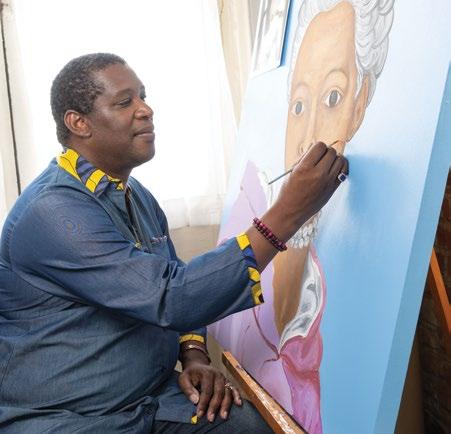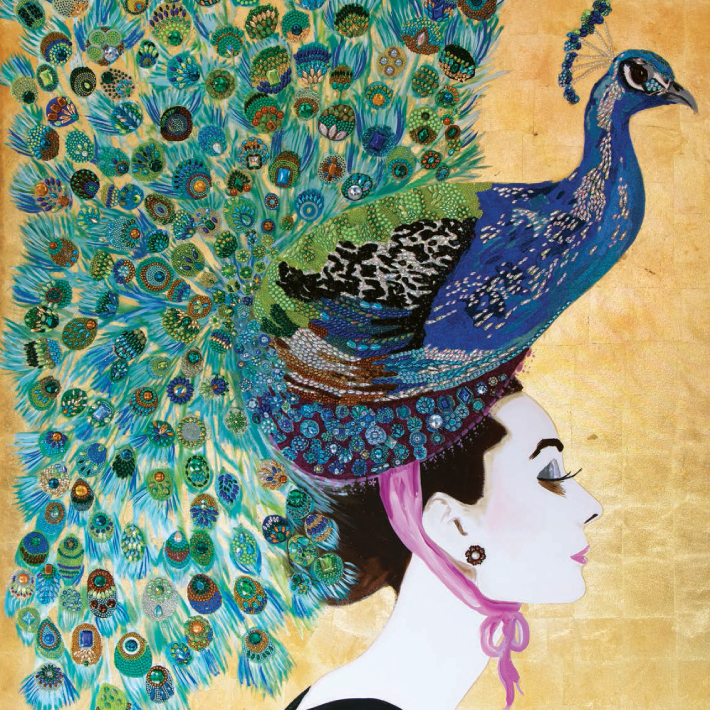Vibrant Visions of the Past

Cover Artist Andrew LaMar Hopkins Illuminates Creole Culture
WE HAVE MANIFESTED OURSELVES TO CREOLE PARIS, HONEY!
On a crisp September night in Paris, patrons of the arts converged steps from the Palais Garnier, the illustrious opera house in the pulsing heart of French fashion. Behind towering, ancient French doors, a dimly lit courtyard was the prelude to an awe-inspiring art gallery. Within the gallery, the “Outsider Art Show” featured artists from around the world, but it was the captivating work of folk artist Andrew LaMar Hopkins that drew the crowd, the cameras, and the interest of some of the world’s most esteemed art critics.
Hopkins is more than just an artist; he’s a storyteller, an historian, and a visionary. His passion for history, antiques, and art converge to create a truly novel and immediately distinguishable art collection. His is a distinct voice in the art world, resonating with authenticity and captivating power.
Born in Mobile, Hopkins moved to New Orleans during his formative years. As a child, Hopkins became a Francophile and Antiquarian, drawn to French royal life, its architecture, and antiques. He voraciously consumed French culture, spending hours at the library pouring over every book on the subject.
Eventually, Hopkins began building miniatures of the architecture, antiques, and décor he admired and studied, leading him to paint. Hopkins’ creations brought a means of escape and allowed him to manifest a reality that transported him from his humble surroundings.
Hopkins’ insatiable appetite for knowledge animates his work. Creole life and culture became his muse, a guiding light that inspires and informs his works. He has manifested his dream life as an internationally acclaimed artist. Today, he lives and paints in France, Creole New Orleans, and Anglo-Saxon Savannah.

Hopkins’ works examine the heritage and celebrate the diversity of his subjects while depicting them adorned and immersed in the period trappings of wealth, success, and opulence. In so doing, he reclaims role models from a whitewashed history. The Creole figures Hopkins paints, against all odds, each reached the pinnacle of success in their respective fields. Although their heritage is often largely unknown, many are household names, like Edgar Degas and John James Audubon. Hopkins also paints well-known icons of Creole history, like Toussaint Louverture and Marie Laveau, a favorite subject of the artist.
His paintings are a detailed window of the time, people, and places he depicts, often in striking and mesmerizing miniatures that capture the essence of his subjects. Hopkins is not a professional historian, at least not in the academic sense, yet his artwork conveys a view of a forgotten history in simple but brilliant terms. In acrylic on canvas, Hopkins speaks a universal language. One that is remarkably accessible, encapsulating a depth of context beyond what any scholarly text could convey. In his art, history unfurls. It is told not through the esoteric jargon of the ivory tower but through a visual language everyone can understand.
Hopkins’ work is characterized by rich, bold colors and magnificent period details synonymous with opulence and success but rarely associated with historical depictions of people of color.

CREOLE NEW ORLEANS RIGHT NOW, HONEY!
I first met Andrew LaMar Hopkins a month before the Paris show at his home and studio, which he affectionally refers to as “Le Chateau de Hopkins,” in the heart of the French Quarter for a wide-ranging interview on his art and life.
An easel displays larger works, including his cover piece for “The Magazine Antiques, 100-year Anniversary Edition” and another large work he is completing for an upcoming show at the Los Angeles flagship gallery of Blum and Poe, which also has locations in New York and Tokyo.
His first easel allows him to paint in the natural light that flows abundantly from the French doors that open onto his wraparound balcony while catching a breeze off the Mississippi River. His second easel, a table just outside his kitchen, is where the artist toils late into the night, adding minute details to his works with singlehaired brushes under a focused light.

WE HAVE MADE IT INTO THE NEW YORK TIMES AGAIN, HONEY!
The art world has been ablaze for Hopkins’ unique work: Pulitzer Prizewinning art critic Jerry Saltz said of Hopkins’ work, “People should see it. It isn’t stuck in the trauma narrative or the pain fetish of art. His art is about life lived in peacock glory, dazzling, crazy, and it has this great sexuality.”
His sold-out debut show at the prestigious Venus Over Manhattan, titled “Creolite,” propelled a meteoric rise in his career. The show was organized by world-renowned curator and art historian Alison M. Gingeras, who was among the first internationally to recognize Hopkins’ genius.
One must not overlook the painstaking effort that Hopkins pours into his work. He stands apart from his contemporaries, producing extraordinarily detailed creations that demand an immense investment of time. Hopkins’ commitment to delivering intricate works sets him apart in the art world. This dedication, while enhancing his reputation, comes with the trade-off of his time, leading to a critical level of scarcity in his highly sought-after original artwork.
Deferential to his roots, Hopkins chose the prestigious Louisiana State Museum in the Cabildo on Jackson Square in New Orleans for his first solo museum show exhibition. He became the first living artist and artist of color to host a solo show at the Cabildo. The beloved exhibit, titled “Creole New Orleans Honey! The Art of Andrew LaMar Hopkins,” was the most attended in the history of the Cabildo, ending after a one-year run on September 30, 2023.
Andrew LaMar Hopkins’ meteoric rise in the art world shows no signs of slowing, promising a future as bright as the captivating work he creates. His exceptional ability to breathe life into forgotten histories by incorporating stunning antiques, architecture, vivid colors, and undeniable joie de vivre firmly sets him apart. His work is a beacon of cultural enlightenment, leaving a profound mark on outsider and folk art. Undoubtedly, his influence will continue to educate, inspire, and resonate for many generations.




